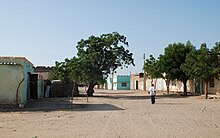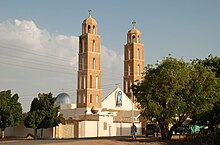Kusti
|
Arabic كوستي Kusti |
||
|---|---|---|
|
|
||
| Coordinates | 13 ° 10 ′ N , 32 ° 40 ′ E | |
| Basic data | ||
| Country | Sudan | |
| an-Nil al-abyad | ||
| ISO 3166-2 | SD-NW | |
| Residents | 316,647 (2013 (estimate)) | |
Kusti ( Arabic كوستي Kūstī ; Alternative spelling Kosti ; Known in the 19th century as Goz Abu Guma or Gor-Abu-Gama ) is a city on the White Nile in the Sudanese state of an-Nil al-abyad .
location
The city is located at around 390 meters above sea level on the western bank of the White Nile , around 260 kilometers south of Khartoum and thus in the middle of the road connecting the capital to El Obeid . Across from Kusti on the eastern bank of the river is Rabak , the capital of the state of An-Nil al-abyad .
population
For the Kusti area there are 316,647 inhabitants (2013 calculation).
Population development:
| year | Residents |
|---|---|
| 1973 (census) | 65,404 |
| 1983 (census) | 91,946 |
| 1993 (census) | 173,599 |
| 2013 (calculation) | 316,647 |
economy
The most important employer in the region with around 12,000 employees is the Kenana Sugar Factory , located on the eastern side of the Nile near Rabak . It is a stock corporation in which, in addition to the Sudanese state, the government of Saudi Arabia and, among others, a Kuwaiti company and the British mining company Lonrho are involved. In the 1970s, sugar cultivation south of the Gezira plain was massively promoted under President Numeiri with loans from the World Bank. Due to corruption and mismanagement, the Kenana sugar-growing project initially turned out to be in deficit; since the record harvest of 2001, Kenana has been one of the world's most efficient sugar factories . From 1990 Sudan began exporting sugar to neighboring countries. In 2006 production was 450,000 tons, further expansion of capacity, export to the European Union after 2009 and participation in the biofuel business are planned. The sugar cane fields, irrigated by canals, are located between Kusti and Sennar . The Asalaya Sugar Factory irrigation project is also located east of the Nile .
Kusti is a trading center for cotton growing on the White Nile.
Because of the civil war in South Sudan , plans to build an oil refinery in Kusti were abandoned in 1982 . As an alternative, the operating company White Nile Petroleum Company decided in 1985 to build a pipeline from the oil production area around Bentiu via Kusti to the refinery near Port Sudan . In 2007 a new proposal was made to build a refinery in Kusti.
Cityscape
The center of the city is the market district Souq Kebir ("big market"), laid out in a right-angled street network, on the bank of the Nile with the river port and the train station south of it. Three kilometers away in a south-westerly direction is a newer, larger market area in terms of area, the Souq Shabi ("young market"), with small craft shops and the central bus station. There are extensive residential areas around the center.
Infrastructure
Street
Kusti is connected to Khartoum by a good asphalt road.
Waterway
The river port serves the exchange of goods up the Nile via Malakal to Juba . The operation of the once weekly passenger ship to Juba ceased with the beginning of the civil war in 1983 and has not been resumed since. The few barges on the Nile are in poor condition and are forced to take a break when the tide is low. These ships need 7 days downstream from Juba and 21 days upstream. The port of Kusti has no loading cranes.
rail
Kusti's train station ( 13 ° 9 ′ 53 ″ N , 32 ° 40 ′ 37 ″ E ) is on the Khartoum – Nyala railway line . Passenger traffic on this route has been discontinued. A few kilometers to the east of the city is the old Kusti railway bridge .
A serious railway accident occurred near Kusti on January 16, 1987 , in which 21 people died and 45 more were injured.
air traffic
The airport has a flight path length of 1338 meters and the international identifier KST.
Attractions
On the nearby river island of Aba, which is 14 kilometers long, is the al-Kar mosque of Muhammad Ahmad , who taught here and declared himself a Mahdi in 1881 . The island can be reached via Rabak and connected to the mainland by a dam.
Individual evidence
- ↑ Archived copy ( Memento of the original dated December 29, 2011 in the Internet Archive ) Info: The archive link was automatically inserted and not yet checked. Please check the original and archive link according to the instructions and then remove this notice. World Gazetteer
- ↑ Meghan Sapp: Sudan, securing its future in sugar. New Agriculturist, November 1, 2005
- ↑ Stephen Williams: Kenana hits record sugar harvest. ( Memento from July 16, 2012 in the web archive archive.today )
- ^ Sugar factory in Sudan to double production. Agência de Notícias Brasil-Árabe - SP, January 30, 2007
- ↑ Sudanese Squabble Over Oil Revenues. Global Policy Forum, July 2000
- ^ Fact Sheet II. The Economy of Sudan's Oil Industry. (PDF; 350 kB) ECOS, October 2007
- ^ River Transport and Barge Operations. UNJLC, December 8, 2005
- ^ Peter WB Semmens: Catastrophes on rails. A worldwide documentation. Transpress, Stuttgart 1996, ISBN 3-344-71030-3 , p. 211.





